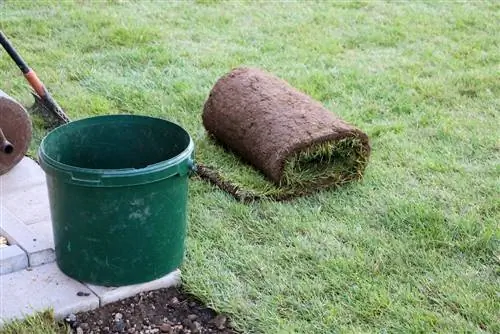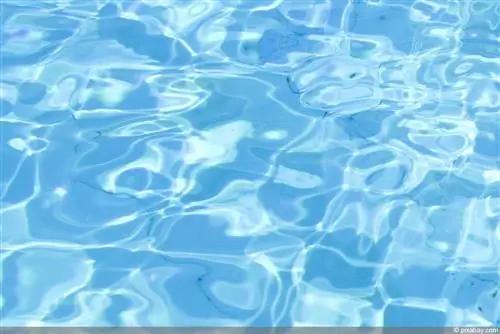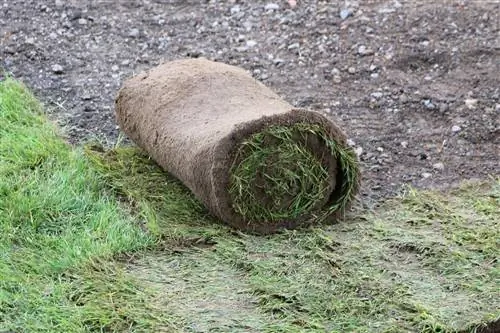- Author admin [email protected].
- Public 2023-12-17 03:39.
- Last modified 2025-01-24 12:45.
What was just a construction site now appears in lush green. Above all, the quick greening and creation of a finished lawn without a long waiting time encourages gardeners and homeowners to choose a rolled lawn. However, anyone who thinks that lawns grow everywhere is wrong. In unfavorable location and soil conditions, the lawn dries out quickly or is replaced by unwanted moss. That's why a good surface is important - even with turf.
Profile
- other name: sod, finished lawn
- finished piece of lawn including roots
- is sown in large areas and harvested after about a year
- very high quality seeds
- dense, closed turf
- almost weed-free, dense and lush green
- Variants: sports turf, play turf, premium turf
When should turf be laid?
In principle, rolled turf can always be laid if the ground is frost-free. In principle, it is also possible to lay it out in midsummer, but the lawn has to be watered very frequently in order to grow. The turf project is best carried out in spring. Then the lawn has enough time to grow and does not need to be watered constantly. A freshly laid turf is fully resilient after just a few weeks.
Preparing the soil
What many hobby gardeners underestimate: Only with good soil preparation will a turf grow optimally and remain dense and lush green. It is therefore important to take a close look at the condition of the soil in advance. In very few gardens the subsoil is really optimal.
1. Remove old lawn
Do you want to replace your old lawn with a new turf? Perhaps it is full of weeds and moss or is only growing sparsely? Without changes to the soil environment, the new turf will quickly look similar. In order for the rolled turf to be laid, the old turf must first be removed. The best way to do this is to use a sod peeler, which simply cuts off the grass and its roots at a certain depth.
2. Check soil condition
Before you start working on the soil, you should remove all roots, stones and plant debris.
- Check soil conditions (heavy, sandy or humus)
- Is the soil well permeable to water or does it tend to become waterlogged?
- Is the subsoil clayey and heavy or is it humic and finely crumbly?
- Does the soil consist of a high proportion of sand or clay?
- What pH value does the soil have?
Lawn prefers humus-rich soils that are able to store water well but do not produce waterlogging. If you have less than ideal soil in your garden, that's not a problem. You can easily and specifically improve your garden soil.
Tip:
If you are not sure about the properties of your garden soil, you can have a soil analysis carried out. An analysis set is available from specialist retailers for around 20 euros.
3. Improve soil
If the ground conditions are not optimal, now is the unique opportunity to change something. This is usually very simple:
- mix heavy clay soils with compost (humus) and sand
- process sandy soils with humus
- very acidic pH values: lightly lime the soil

Then you should level the area by eye so that there are no rough unevenness in the ground.
4. Loosen the soil
For small lawns, the soil can be dug up with a digging fork or a spade. If larger areas are planned, the gardener will find it easier with a garden tiller or rotary harrow. These can be rented from gardening equipment rental shops for relatively little money. At least 10 centimeters of soil depth must be loosened, more is even better. Additives such as sand, humus or lime can be incorporated into the soil.
5. Fine straightening
Now level the loosened soil with a fine rake. Please take a lot of care in this step, as later unevenness can only be corrected with great effort. Remove any coarse debris that collects on the surface.
6. Reels
The top layer of the soil is now very loose. If the turf were applied immediately at this point in time, rainwater would cause it to wash out and settle over time. To prevent this, the raked area is secured with a garden roller. If any unevenness is still visible, these are straightened out again with the rake and rolled again.
Tip:
The distance between the top edge of the path or terrace stone and the leveled surface should be around 2 centimeters. This is the only way the turf can be laid flush later.
7. Starting fertilizer
If you have not carried out a soil analysis and can therefore fertilize specifically, you should definitely treat your turf to a special starter fertilizer so that the lawn can grow well.
8. Rake again
Once the area has been fertilized and rolled, it is carefully raked up again to a depth of about 1 centimeter. In this way, the fertilizer is worked into the soil, the immediate subsoil is loosened and smaller unevenness (such as footprints) is leveled out.
Tip:
If you often have problems with moles in your garden, we recommend installing a special mole protection fabric.
Laying turf
Rolled turf is usually delivered in long, narrow strips that were folded into a roll during transport. After arriving in the garden, the turf must be laid immediately and under no circumstances should it be left rolled up for a few hours.
- start on the terrace or sidewalk side
- lay on one long side (not in the middle)
- best on a straight side
- Lay curved edges at the end
- Lay the turf onto the raked area without any gaps
- roll with a garden roller after complete installation
- so he gets good contact with the underground
After laying, you now have to water the lawn very carefully and evenly - even when the sun is shining! Otherwise the lawn will dry out and not grow. As a rough measure of the amount of water, you can expect around 20-25 liters per square meter. Important: You may not walk on the lawn afterwards because the ground is now very soft.
Tip:
If it is very hot, you should not wait until the entire lawn has been laid before watering, but must water sections that have already been laid.
Care instructions for rolled turf
1. Water
In the first two weeks, the grass roots do not have any intensive contact with the subsoil. Therefore, in dry weather, the sod must always be kept moist with a garden hose (at least once a day). If possible, avoid walking on the lawn during this time!
2. Mowing
The first cut on a new turf is something very special and must be carried out with a little care. This also includes freshly sharpened blades for lawnmowers.
- Time: after about 8-14 days
- the lawn must not be higher than about 7-10 centimeters
- Do not cut deeper than 5 centimeters when making the first cut
- further cuts: between March and October once a week to about 4 cm
- shorter cuts cause the lawn to burn quickly
3. Fertilize
After about six weeks, the nutrients from the starter fertilizer are used up. During the growing season you should fertilize with lawn fertilizer about 3-4 times. Quantity: 50g per square meter. Alternatively, use slow-release fertilizer.
Prices for turf
Depending on the quality, a square meter of turf including delivery is available from around 3 euros. If the purchase quantity is small, the price increases to around 5-6 euros. The rolled turf is usually delivered in strips each 40 cm wide and 2.5 m long.






